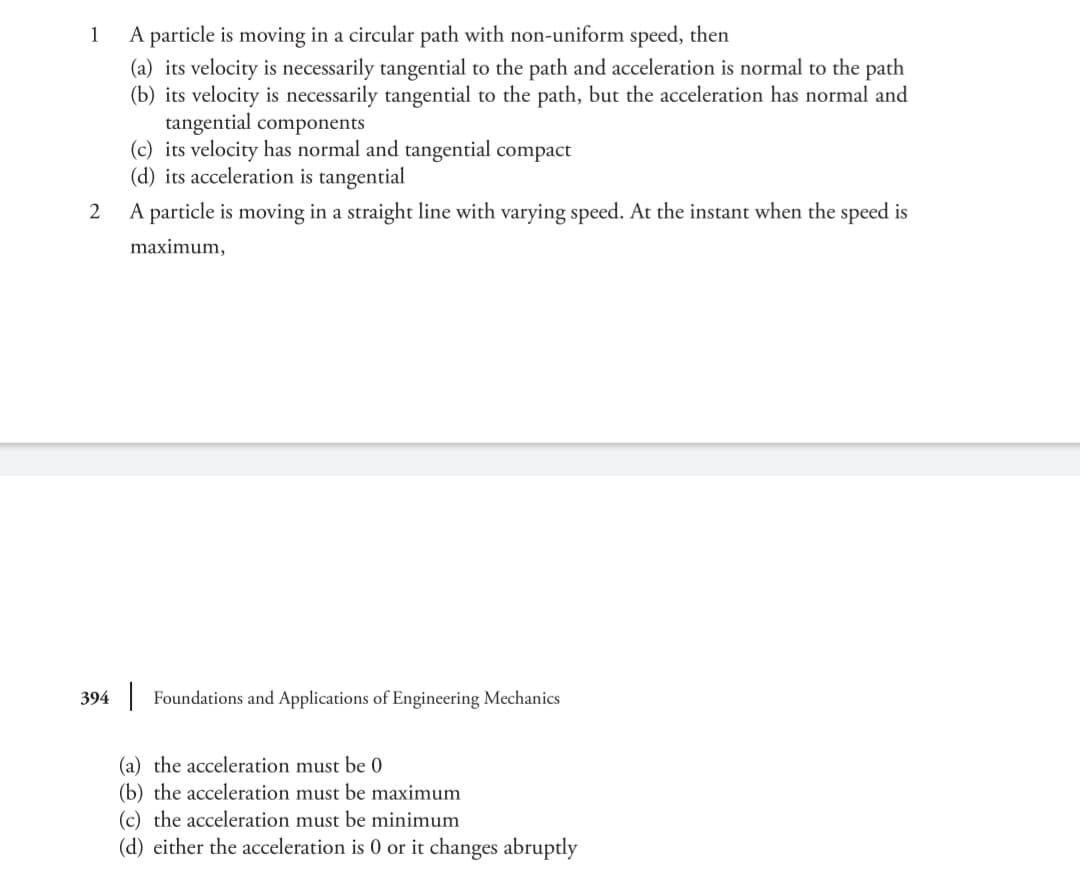A particle is moving in a circular path with non-uniform speed, then (a) its velocity is necessarily tangential to the path and acceleration is normal to the path (b) its velocity is necessarily tangential to the path, but the acceleration has normal and tangential components (c) its velocity has normal and tangential compact (d) its acceleration is tangential 1 2 A particle is moving in a straight line with varying speed. At the instant when the speed is maximum,
A particle is moving in a circular path with non-uniform speed, then (a) its velocity is necessarily tangential to the path and acceleration is normal to the path (b) its velocity is necessarily tangential to the path, but the acceleration has normal and tangential components (c) its velocity has normal and tangential compact (d) its acceleration is tangential 1 2 A particle is moving in a straight line with varying speed. At the instant when the speed is maximum,
Elements Of Electromagnetics
7th Edition
ISBN:9780190698614
Author:Sadiku, Matthew N. O.
Publisher:Sadiku, Matthew N. O.
ChapterMA: Math Assessment
Section: Chapter Questions
Problem 1.1MA
Related questions
Question
Please explain step by step.

Transcribed Image Text:A particle is moving in a circular path with non-uniform speed, then
(a) its velocity is necessarily tangential to the path and acceleration is normal to the path
(b) its velocity is necessarily tangential to the path, but the acceleration has normal and
tangential components
(c) its velocity has normal and tangential compact
(d) its acceleration is tangential
1
2
A particle is moving in a straight line with varying speed. At the instant when the speed is
maximum,
394 Foundations and Applications of Engineering Mechanics
(a) the acceleration must be 0
(b) the acceleration must be maximum
(c) the acceleration must be minimum
(d) either the acceleration is 0 or it changes abruptly
Expert Solution
This question has been solved!
Explore an expertly crafted, step-by-step solution for a thorough understanding of key concepts.
Step by step
Solved in 2 steps

Knowledge Booster
Learn more about
Need a deep-dive on the concept behind this application? Look no further. Learn more about this topic, mechanical-engineering and related others by exploring similar questions and additional content below.Recommended textbooks for you

Elements Of Electromagnetics
Mechanical Engineering
ISBN:
9780190698614
Author:
Sadiku, Matthew N. O.
Publisher:
Oxford University Press

Mechanics of Materials (10th Edition)
Mechanical Engineering
ISBN:
9780134319650
Author:
Russell C. Hibbeler
Publisher:
PEARSON

Thermodynamics: An Engineering Approach
Mechanical Engineering
ISBN:
9781259822674
Author:
Yunus A. Cengel Dr., Michael A. Boles
Publisher:
McGraw-Hill Education

Elements Of Electromagnetics
Mechanical Engineering
ISBN:
9780190698614
Author:
Sadiku, Matthew N. O.
Publisher:
Oxford University Press

Mechanics of Materials (10th Edition)
Mechanical Engineering
ISBN:
9780134319650
Author:
Russell C. Hibbeler
Publisher:
PEARSON

Thermodynamics: An Engineering Approach
Mechanical Engineering
ISBN:
9781259822674
Author:
Yunus A. Cengel Dr., Michael A. Boles
Publisher:
McGraw-Hill Education

Control Systems Engineering
Mechanical Engineering
ISBN:
9781118170519
Author:
Norman S. Nise
Publisher:
WILEY

Mechanics of Materials (MindTap Course List)
Mechanical Engineering
ISBN:
9781337093347
Author:
Barry J. Goodno, James M. Gere
Publisher:
Cengage Learning

Engineering Mechanics: Statics
Mechanical Engineering
ISBN:
9781118807330
Author:
James L. Meriam, L. G. Kraige, J. N. Bolton
Publisher:
WILEY